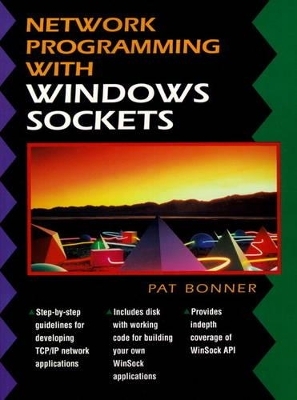
Network Programming with Windows Sockets (Bk/Disk)
Prentice Hall
978-0-13-230152-7 (ISBN)
- Titel ist leider vergriffen;
keine Neuauflage - Artikel merken
This book is for the programmer developing Windows applications running on a TCP/IP network. Referenced in Microsoft documentation, it contains everything you need to become a TCP/IP programmer in a Windows environment focusing on industrial strength, real-world applications. The accompanying disc contains sample programs written in C, the programming language of choice for this application.
Preface. Acknowledgments. 1. Networking Overview. Network Links, Networks and Internetworks. Protocol Stacks. Network Interfaces. The TCP/IP Protocol Suite. Computer Names and Add1resses. Network Services. An Example. Road Map for Reading this Book. 2. Introduction to Windows Sockets. The Significance of the Windows Sockets Specification. The History and Status of WinSock. The WinSock Group. Obtaining WinSock Information. Guiding Goals for Windows Sockets Version 1.1. The Relationship of Window Sockets to Other Network Components. Developing Programs with Windows Sockets. A Brief Summary of Windows Sockets Commands. 3. Introduction to Using Stream Sockets. The socket Command. Addressing and Address Data Structures. Stream Socket Connection Establishment. Synchronization of Commands/Blocking Modes. Data Transfer for Stream Sockets. Closing Stream Sockets. Byte Order. 4. Programming with the Windows Sockets Extensions. Summary of New Commands in Windows Sockets. Mandatory Commands. Command Failure and Error Processing. Asynchronous Notification/WSAAsyncSelect(). Overview of Sample Application. Server Application. Client Application. Additional Comments on the Sample Client and Server Applications. Extending the Server Application to Handle Multiple Clients. 5. Using Blocking and Polling Socket Calls. Implications of Blocking in Windows. Commands That May Block. DefaultBlockingHook() and the Blocking Loop. Handling Reentrancy. Sample Blocking Application. Modifying the Blocking Hook Procedure. Polling for Event Completion. Sample Polling Application. Summary of Polling Methods by Event Type. 6. Using the Database Functions. Introduction to the Database Functions. Using gethostbyname() and gethostbyaddr(). Dynamic Name/Address Resolution Methods. Using WSAAsyncGetHostByName(). Service Information Functions. Protocol Information Functions. Getting the Address of the Local Machine. 7. Using Datagram Sockets. Characteristics of Datagram Communication. Creating, Binding, and Closing Datagram Sockets. Sending and Receiving Data. Overview of Sample Disk Space Information Datagram Application. Disk Space Information Server Program Disk Space Information Client Program. Typical Sequence of Events for the Server and Client Applications. Using Broadcast Functionality. Optional "Connect" Functionality. Summary of Windows Sockets Commands as Used for Datagrams. A Description of TFTP. 8. Developing Stream Socket Applications. Network Interface Considerations. Protocols. Connection State Records. Network State Transition Graphs and State/Event Matrices. Error Processing. Sample PC to PC File Transfer Program. Sample Program Interface. Sample Program Protocol. Sample Program Connection State Records. Server Program States. Client Program States. Sample Program Error Processing. More on Sample Server Program Code. More on Sample Client Program Code. Description of FTP. 9. Using Windows Sockets from a DLL. Accessing Windows Sockets from an Intermediate DLL. Issues Specific to Using Windows Sockets from a DLL. Model 1 - App/Intermediate DLL/WINSOCK DLL Architecture. Model 2 App/Intermediate DLL/WINSOCK DLL Architecture. More Complex App/DLL/WINSOCK DLL Environments. Introduction to the TELNET DLL. Summary of the TELNET Protocol. TELNET DLL Interface. The Connection State Record. State Transition Graph and State/Event Matrix. Error Processing/Resource Management. The Model 1 TELNET DLL Implemention. The Model 2 TELNET DLL Implementation. 10. Analyzing LAN Traces. Using a LAN Analyzer. TCP Message Types and Sequences. An Individual Message Format. Sample LAN Trace. More on TCP Header Fields. Appendix A. Differences Between Windows Sockets and BSD Sockets. Appendix B. Examples of Dynamic Runtime Import of WINSOCK.DLL. Appendix C. Summary of FTP. Appendix D. Summary of the TELNET Protocol. Index.
| Erscheint lt. Verlag | 19.10.1995 |
|---|---|
| Verlagsort | Upper Saddle River |
| Sprache | englisch |
| Maße | 173 x 235 mm |
| Gewicht | 1008 g |
| Themenwelt | Informatik ► Betriebssysteme / Server ► Windows |
| Mathematik / Informatik ► Informatik ► Netzwerke | |
| ISBN-10 | 0-13-230152-0 / 0132301520 |
| ISBN-13 | 978-0-13-230152-7 / 9780132301527 |
| Zustand | Neuware |
| Haben Sie eine Frage zum Produkt? |